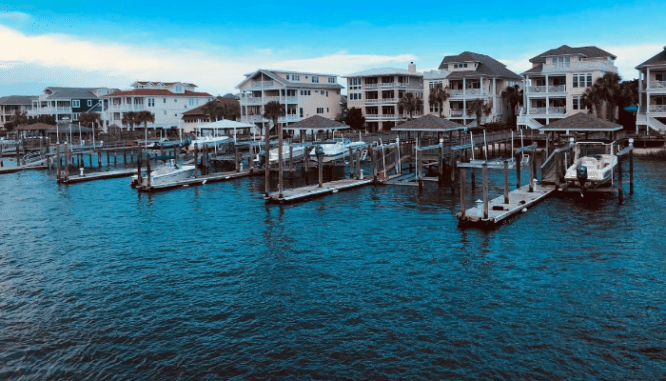10 Tips for Selling Your House in a Flood-Prone Area As Risks Rise
- Published on
- 6 min read
-
 Caroline Feeney Former Executive EditorClose
Caroline Feeney Former Executive EditorClose Caroline Feeney Former Executive Editor
Caroline Feeney Former Executive EditorCaroline Feeney was previously HomeLight's Executive Editor / Director of Content. With 7 years of real estate reporting and editing experience, she previously managed content for Inman News and co-authored a book on real estate leadership. The Midwest native holds a master's from the Missouri School of Journalism and was formerly a real estate contributor for Forbes.
Experts suggest that more and more homeowners will find themselves in an area considered “flood prone” — in fact, projected flood plains are anticipated to grow by up to 45% by the end of the century.
If this is you now, and you’re looking to put your property on the market, follow these tips for selling a house in a flood-prone area. We’ll help you navigate the ins and outs of flood insurance, invest in any advisable floodproofing improvements, and make your house as marketable as possible to the right buyer who’s willing to accept the risks.
What does it mean to live in a “flood-prone” area?
First, let’s get the terminology straight because there’s a lot of different vocab to understand when it comes to real estate and flooding. A “flood prone” area — also known as a floodplain — refers to “any land area susceptible to being inundated by water from any source during a 100-year flood as defined by FEMA (Federal Emergency Management Agency) or FHAD (Flood Hazard Area Delineation),” according to a local government office.
If you own a house in a moderate flood zone (between the 100-year and 500-year flood levels) or a low risk flood zone (above the 500-year flood level) you’re not technically “flood prone” per current guidelines — but you can still benefit from the guidance here.
The biggest difference is that mandatory flood insurance requirements don’t typically apply to moderate and low risk zones — though obtaining insurance is still often advisable, according to FEMA. Even if you have checked your zone previously, it’s advisable to check again as FEMA re-surveys areas from time to time and your zone may have changed, which brings us to our first piece of advice.

Tip #1: Verify your flood zone tier and insurance requirements
According to FEMA, 13 million homeowners live in the high risk 100-year flood plain, which means they face a 1% chance of flooding during any given year and a 26% chance of flooding over the life of a 30-year mortgage. You’ll know if you’re technically in a “flood prone” area if your community falls into any FEMA-designated flood zone starting with letters “A” (High Risk Areas) or “V” (High-Risk Coastal Areas) where those mandatory flood insurance purchase requirements come into play.
Outside of the 100-year floodplain, Zone B and shaded Zone X designate areas at moderate risk for flooding. If you’re in a Zone C or unshaded Zone X, your home is at minimal risk for flooding. You can check your zone using FEMA’s Flood Map Service Center. To find out if your community participates in the National Flood Insurance Program (NFIP), go to FEMA’s National Flood Insurance Program Community Status Book or talk to your insurance agent.
Tip #2: Have your property surveyed for an elevation certificate
If your property is in a flood-prone area but you don’t believe you belong there, you can have a surveyor provide an elevation certificate that you can submit to FEMA to be removed from that flood zone. In fact, FEMA advises that “it may surprise you to learn that some policyholders with grandfathered policies could be paying less for their flood insurance today if they had specific elevation information for their building.”
An elevation certificate is a document that lists a building’s location, lowest point of elevation, flood zone, and other characteristics. If your property is considered to have a high risk of flooding, you’ll likely need to obtain FEMA’s elevation certificate for your property before you can buy flood insurance.
If you obtain proof that you’re in the wrong zone, you can go online and submit a Letter of Map Change (LOMC) request. In addition, the eLOMA site allows licensed land surveyors and professional engineers to submit Letter of Map Amendment for you.

Tip #3: Make any necessary flood disclosures
Liz McCarthy, a top agent in San Rafael, CA (an area with a long history of flooding) always prepares a flood disclosure packet on behalf of her flood-prone seller clients.
She includes all pertinent information concerning the property, the designated flood zone, information about insurance, and more to make sure everyone is on the same page. California has a special form called the natural hazard disclosure report (NHD) that sellers use to make disclosures about flooding and other nature-related risks such as earthquakes.
But some states are a lot more lax, putting the onus on you to be transparent about flooding information out of good faith. 29 states have flood disclosure mandates of varying degrees, but 21 states require no flood disclosure requirements at all, the Natural Resource Defense Council (NRDC) reports. Check out the NRDC’s Flood Disclosure Map to see the regulations relevant for your state.
However, regardless of your individual state’s laws, the general rule real estate experts go by is this: you should never hide material facts that could impact your home’s value or safety, including its history of flooding, flood zone status, or insurance requirements.
What’s more, if you’ve received federal disaster assistance on your home, you will be required to obtain flood insurance at that address. From there, federal law does require that when you sell your home, the new owners be informed that they’ll need to continue insurance coverage on the property, according to FEMA. If you have any questions about what you’re legally required to disclose, talk to your agent and, if necessary, a skilled real estate attorney.
Tip #4: Request a CLUE report
While it’s a smart idea to be transparent about your flood zone and any history of flooding, on the other side of the coin, you want to put buyers minds’ at ease using cold hard facts. If you have never had to pay a claim for flooding — or the area has not flooded for many years — that works to your advantage. And you can request a claims-information report generated by LexisNexis, a consumer-reporting agency, to show buyers your property’s lack of flood events with clear documentation.
You can obtain this report, called a Comprehensive Loss Underwriting Exchange (CLUE) through the link or by calling 866-312-8076. The report contains up to 7 years of personal claims history. The Fair Credit Reporting Act Entitles you to a free copy. This will let you show potential buyers that no claims have been filed, and the risk of flooding is low.

Tip #5: Offer to transfer your flood insurance to the buyer if possible
If you don’t have flood insurance because it’s not required, you still may want to consider getting it before you put your house on the market.
According to FEMA, “even if you live outside a high-risk flood zone, called a Special Flood Hazard Area, it’s a wise decision to buy flood insurance. In fact, statistics show that people who live outside the high-risk areas file more than 25% of flood claims nationwide.”
This will help protect your home should a flood occur while it’s on the market. In addition, some policies allow sellers to transfer an existing policy to a new buyer with no lapse in coverage — so this can be a nice selling point for your home. Already having a policy in place may be beneficial to the buyer because, according to FEMA “if the rate is subsidized, the rate can be transferred.”
Tip #6: Private vs. public insurance: Make sure you’ve got the best policy for your property
While most flood insurance is federally regulated through the NFIP, you can also buy private flood insurance on the market. As of 2018, private flood insurance makes up about 15% of flood insurance policies nationwide, according to a report from Insurance Journal.
If you live in a lower risk flood zone, you might find private offerings to be more affordable. The drawback of private insurance is if your area becomes higher risk over time, your provider can choose to not renew your policy, which could result in higher rates.
You’re going to find that public health insurance policies generally offer lower rates for high-risk areas. Do some research on the FEMA National Flood Insurance Program (NFIP) website FloodSmart if you’re looking for a public flood insurance provider.

Tip #7: Collect details around your property’s flood insurance pricing
If you’ve been paying flood insurance, one way to reassure buyers about the additional cost is to share with them what you pay. Collect your past flood insurance bills so you can show them the premiums and rate increases over time. Check to see if your insurance is transferable by calling your carrier to inquire.
Tip #8: Offer to pay for flood insurance as a buyer incentive
Paying for one year of insurance can bring a lot of peace of mind and could entice a qualified buyer who’s otherwise feeling leery to make an offer. Another option is to adjust the selling price to account for the insurance premium costs for that first year.

Tip #9: Emphasize the reward for the risk
An increased flood risk often goes hand in hand with something buyers love: water views, close proximity to the water, and perhaps even private access to the water. In fact, counties directly on the shoreline account for less than 10% of total U.S. land area, but 39% of the total population, according to the National Ocean Service. Despite the risks, people love the coast and being near any kind of beautiful or usable bodies of water. If your property offers exclusive activities like fishing, swimming, or boating, make sure that you market these perks. Be sure to highlight any waterfront views with professional photos in your online listing.
Tip #10: Take reasonable flood-proofing measures
According to a report from CityLab, your best line of defense against water intrusion when you live in a flood-prone area is elevation. However, raising a house that’s already been built will cost you between $180,000-$250,000, not exactly a feasible expense for everyday homeowners.
Other floodproofing strategies are more for when you know a flood is coming, like installing watertight shields over your windows and doors. But there are some reasonable and more permanent flood proofing measures you can take before you sell your home, which buyers may find value in. The NRDC offers a few smart suggestions:
- Raise your utilities/boiler/HVAC system to higher ground by building platforms or putting them on a higher floor
- Hire a licensed plumber to install a sewage water backstop device
- Use landscaping techniques like digging ditches known as “swales”
- Go for brick and gravel rather than concrete or asphalt
- Install some absorbent mulch
- Place a rain barrel beneath gutter downspout
Selling a house in a flood-prone area: Be transparent and offer what incentives you can
There’s more than one way to find out that your house is flood-prone. Maybe one day you walked in and your heart dropped at the sight of standing water in the wrong places. It’s more likely, however, that your property was located in a high-risk flood zone when you purchased it — or it recently got classified as such.
And after many happy (perhaps flood-free!) years, you have contend with that designation now that the time’s come to sell. When in doubt, hedge on the side of disclosure, get your insurance ducks in a row, and highlight your home’s other perks especially if it involves anything related to water access.
Header Image Source: (Trevor Cole / Unsplash)
